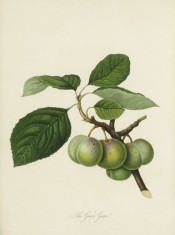Prunus domestica ‘Green Gage’
A Prunus domestica L. cultivar. ‘Branches smooth. Fruit middle-sized, round, having a narrow suture extending from the stalk to the apex. Stalk half an inch long, a little bent, and inserted in a small funnel-shaped cavity. Skin yellowish green, but when fully exposed to the sun of a purplish colour, marbled with russetty muddy red. Flesh yellowish green, very melting, and separates partly from the stone, leaving part of the pulp behind. Juice abundant, saccharine, of the richest and most exquisite flavour. Ripe on the open standard the middle of August.’ [George Lindley – Orchard Guide p.445/1831]. See also Prunus domestica L. var. ‘Reine Claude’.
Horticultural & Botanical History
‘The Plum called by Du Hamel Dauphine, Grosse Reine Claude, Abricot Verte, and Verte Bonne, has long been considered the variety which is cultivated in the English Gardens under the name of the Green Gage. This appellation is said to have originated from the following accident. “The Gage family, in the last century, procured from the Monks of the Chartreuse at Paris a collection of fruit trees; these arrived at their mansion of Hengrave Hall, with the tickets safely affixed to them, except only the Reine Claude, the ticket of which had been rubbed off in the passage. The gardener being, from this circumstance, ignorant of the name, called it, when it bore fruit, the Green Gage.” (Hort. Trans. Vol.1 Appendix, p.8. Note by Sir Joseph Banks). On comparing our variety with the description given by Du Hamel, together with his uncoloured figure, little doubt can remain of its identity; and the coloured plate of the Reine Claude which has appeared in the new edition of the Traité des Arbres Fruitiers, publishing at Paris, in every respect confirms this opinion. […] It is justly esteemed the best variety of its season for the dessert, and is excellent for culinary purposes.’ [PL vol.1, pl.38/1818]. ‘The Green Gage is said to be capable of being reproduced by seed, with little, or sometimes without any, perceptible variation; and it is worthy of observation, that in our gardens, as well as in those of the French, there are many varieties of this fruit differing from each other in the size and colour, as well as in the quality of the fruit. It is therefore of importance to those cultivators who wish to obtain trees or to insert buds of this variety, to be acquainted with the produce of the trees from whence these are taken.’ [PL vol.1, pl.38/1818].
Also figured in Pomonia Britannica [PB pl.XVI/1812].
History at Camden Park
Listed in all published catalogues as ‘Green gage’ [Plum no.9/1843]. See also ‘Reine Claude’.
Notes
The plum ‘Reine Claude' is listed separately by Macarthur in all editions of the catalogues and this is continued in the Hortus. It seems likely that the plums listed as ‘Green Gage’ and ‘Reine Claude’ did differ somewhat from each other, in size, colour or in general quality. These comments by William Hooker in the Pomona Londinensis perhaps provide an explanation. ‘The Green Gage is said to be capable of being reproduced by seed, with little, or sometimes without any, perceptible variation; and it is worthy of observation, that in our gardens, as well as in those of the French, there are many varieties of this fruit differing from each other in the size and colour, as well as in the quality of the fruit. It is therefore of importance to those cultivators who wish to obtain trees or to insert buds of this variety, to be acquainted with the produce of the trees from whence these are taken.’ [PL vol.1, pl.38/1818].
Published May 27, 2010 - 02:32 PM | Last updated Jul 21, 2011 - 05:32 PM
| Family | Rosaceae |
|---|---|
| Category | |
| Region of origin | Garden origin, France |
| Synonyms |
|
| Common Name | Dessert Plum, Culinary Plum, summer to autumn |
| Name in the Camden Park Record |
Green gage |
| Confidence level | high |
